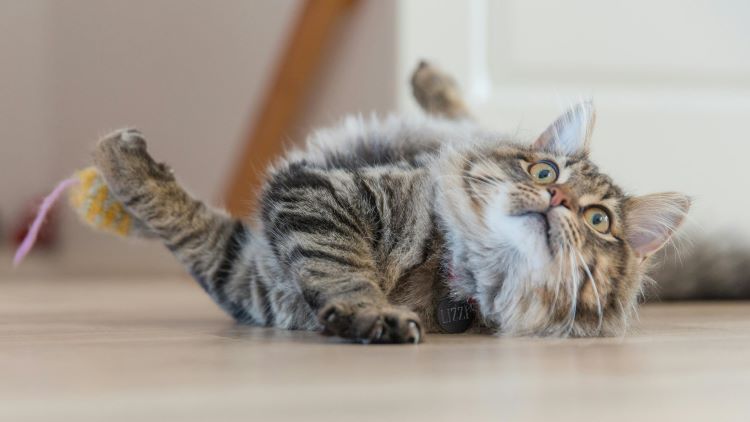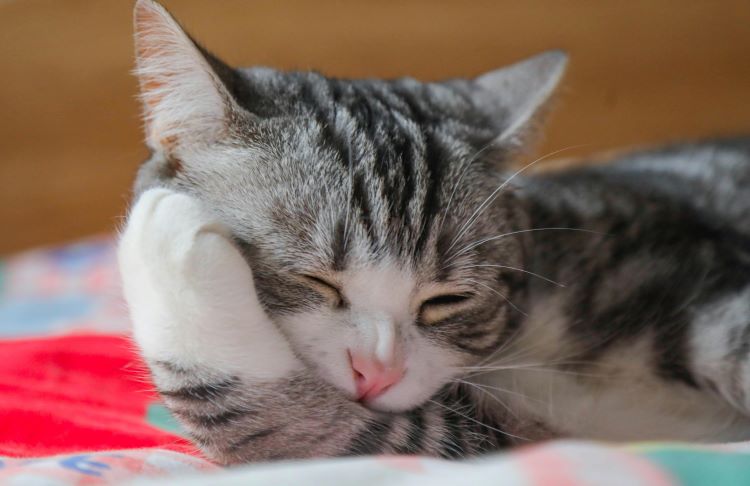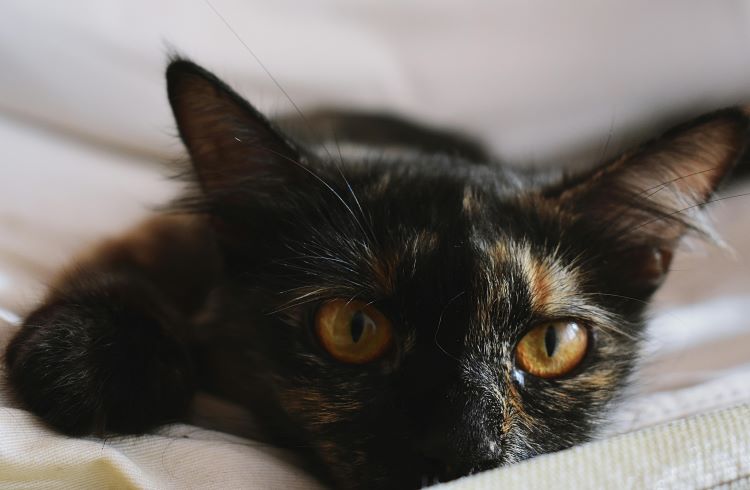Ready to help treat your pet to a healthy life?
8 Ways to Give Catnip to Your Cat
By : Brianna Gunter | Published Oct 29, 2024

My family adopted a cat named Simon when I was a teenager. Simon loved all kinds of treats, but his favorite by far was catnip. Being responsible, we rationed it out in small sprinkles at a time on toys and scratching posts. That is, until one day when Simon broke into a box of pet supplies and ate an entire bag of catnip in one sitting. He thankfully ended up being just fine (following hours of zoomies and rubbing his face on things). But he got a long, healthy break from “the ‘nip” after that.
If Simon were still around today though, he’d have even more catnip choices to be tempted by. Fortunately for modern pet owners, many of these are safer than trying to stash a bag of it away from prying paws. And as long as your veterinarian approves, you might want to try a few different catnip products. From sprays to specially-made toys, some may work better for your cat and home environment than others.
What is catnip anyway?
Catnip is an aromatic herb within the mint family. Scientifically known as Nepeta cataria, it also goes by fun names like “catswort” or “catmint” thanks to its association with our feline friends. Though catnip didn’t start out in North America (it’s originally from Europe, the Middle East, and parts of Asia), this fun little herb has made itself at home here, spreading like mint does — everywhere!
When you buy catnip from the store, it’s usually dried and has been sitting for a while. But just like any herb, dried catnip loses its punch over time. If you do find your cat has an affinity for the herb, keep the fun going by swapping it out for fresh options every now and then.
Keep in mind that although catnip is often compared to cannabis/marijuana for its effects on your pet's behavior (see more on these effects below), it is not the same. Catnip and marijuana are unrelated plant species. Furthermore, catnip is generally safe for cats while cannabis can be toxic. This is why — if you use cannabis or any product with THC — you should always keep it separate and clearly distinguishable from any catnip you have in the home.
How catnip affects your cat
As mentioned, catnip does not actually affect all felines — some are totally indifferent to it. Young kittens have also been found to not have any response to catnip. But what does catnip do to cats that makes many enjoy it?
The herb’s key ingredient is “nepetalactone.” This is a kind of essential oil that interacts with your cat’s brain receptors. Once activated here, cats can display a range of reactions:
- Hyperactivity
- Rolling around
- Vocalizations, including ones they don’t normally make
- Rubbing
- Being overly affectionate
- Prolonged relaxation
- Zoning out
- Aggression, in some cats
According to the Humane Society, research shows that cats tend to be more active when smelling catnip and more mellow when eating it. Occasional use may help cats decrease stress levels and add a little excitement into their day.
In case you’re wondering, no, catnip doesn’t affect humans the same way it does cats. This is because we lack those special receptors that trigger a euphoric response. That said, catnip may still have some mild calming effects on people and may even act as a digestive aid. You’ll want to talk with your own doctor before partaking from your cat’s stash though.

8 types of catnip products to try
You may know that cats can eat catnip (and if you didn’t, you do now), but that’s far from the only way they can enjoy it. Catnip targets special “happy” receptors within your pet’s brain, whether consumed orally or inhaled, or both. Many cats also enjoy rubbing their faces on items treated with the herb. Introduce some variety to your cat’s life by trying a few different catnip options!
Trupanion does not receive compensation for any external products mentioned in this article. External links are for informative purposes only.
1. Catnip sprays
Most pet stores and online retailers these days have multiple catnip-infused sprays to choose from. Try using it on your cat’s bed, scratcher, or toys.
The main pro here is that it’s less messy than dried catnip but still effective in attracting your cat. And, depending on the concentration, it may also be easier to control how much of the herb your cat is exposed to at a time. However, you’ll want to read ingredient labels closely (and go over them with your vet). The safest sprays will be simple, with just catnip oil and distilled water.
2. Catnip scratcher
Some scratching pads and posts come with catnip (either embedded or in a small bag to sprinkle on) to entice cats. You can also add some dried catnip in the grooves of any textured scratcher to renew your cat’s interest in it.
3. Tea
No, this doesn’t mean serving up a steaming cup of catnip tea to your pet (though you may enjoy sipping some yourself as a human). Some natural food stores and pet retailers actually sell catnip tea.
You can also make your own! Steep catnip in hot water for several minutes, then let it cool. Dip a cat toy or pet-friendly cloth in the tea and offer it to your pet. You can also try dipping your fingers into the tea for your cat to sniff, lick, or rub up against.
4. Mounted spinning ball
“Wall balls” and other mounted cat toys have become popular in recent years. For the unfamiliar, these are small toys that stick on your wall via adhesive or can be mounted with hardware to add dimension to your cat’s playtime. But catnip wall toys up the ante even further!
Often coming in convenient packs (since catnip potency fades), look for wall mount catnip ball toys. Your cat can lick, sniff, and paw at them, enjoying a catnip fix and some exercise along the way.
5. Teeth-cleaning toys
One challenge for many cat owners is maintaining their pet’s oral health. But add a little catnip into the mix, and you just might get your cat to “brush” their own teeth. From catnip-infused dental sticks to plant-based chew toys, your cat can have a good time while you can enjoy fresher pet breath.
6. Fresh catnip plant
Why keep buying dried catnip when you can grow your own fresh stuff? Try growing a catnip plant indoors and let your cat nibble on the fresh leaves. It’ll be a non-toxic houseplant your cat can actually play with! And, of course, they’ll love the texture and flavor of fresh catnip.
7. Treats
Catnip treats are often a simple and safe way for felines to enjoy the herb. Combining small doses of catnip with other cat-safe ingredients, these treats can be extra enticing for your pet. From crunchy bites to soft chews, they can be a great way to reward good behavior or just give your kitty a break.
Look for limited, natural ingredients and talk with your veterinarian about which ones may be best for your pet’s needs.
8. DIY catnip toys
You’re probably well-familiar with catnip toys, which are usually small fabric shapes filled with dry catnip. If you’re handy at sewing, you can try making your own. But for those looking for less time-consuming or complex options, there are a few things you can do. For example, sprinkle some dried catnip inside a paper bag and let your cat crawl in. It turns an ordinary bag into an irresistible play spot!
Have a clean sock you’re not using? You can also stuff a (again, clean and unused) sock with dried catnip and tie off the end. Toss it to your cat and voila! They’ve got a fun new toy to bat around.

Practicing safety with catnip
Before you find out if your kitty is a total catnip fiend like Simon, be sure to prioritize safety.
Veterinarians consider catnip to be generally safe for cats, but moderation is key. While catnip overdose is not a known risk, too much can lead to overstimulation or mild stomach upset. Some cats may also be extra sensitive and have negative reactions to even small amounts as a result. If your cat is under three years old, consult with your veterinarian before giving them catnip. Kittens don’t tend to respond to it, but they may still have some sensitivities.
Always supervise playtime with catnip toys, whether your pet is a first-timer or a longtime aficionado. For best results, offer catnip in a calm setting that doesn’t already have a lot of stimuli. And no matter how much your pet likes it, limit exposure to a few times a week to prevent desensitization. If you grow catnip at home, make sure it’s pesticide-free. With a few precautions, catnip can be a fun, safe treat!
While you’re making your cat’s safety a priority, be sure to consider cat health insurance if your pet isn’t already protected.
